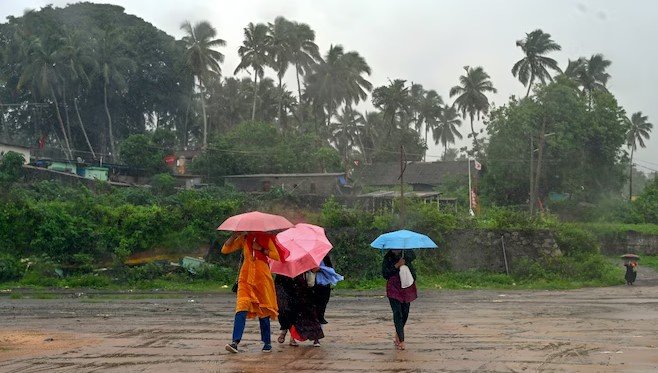The monsoon’s grip tightened across southern India on Monday, with rain lashing roads, flooding towns, and forcing schools to shut down. Weather officials raised multiple red alerts as coastal and hilly regions braced for more trouble.
A mix of rain fury and rising anxiety hung over Kerala and Karnataka, as forecasts hinted there’s more coming. With rivers swelling and roads snapping, the monsoon’s early punch has already started to leave a mark.
Kerala Braces for More Downpours as Red Alerts Expand
The monsoon isn’t knocking politely on Kerala’s door anymore — it’s barged in.
On June 16, the India Meteorological Department (IMD) issued red alerts across five Kerala districts, warning of extremely heavy rainfall. These included Kozhikode, Wayanad, Kannur, Kasaragod, and Malappuram — regions that have often borne the brunt of early monsoon bursts.
As a precaution, authorities declared holidays for schools in at least nine districts. That list reads like a who’s who of Kerala geography — Kasaragod, Kannur, Kozhikode, Wayanad, Malappuram, Thrissur, Ernakulam, Idukki, and Kottayam.
Flood-prone roads are already turning into messy obstacle courses. Waterlogging was reported in various parts of Ernakulam and Kozhikode. A few houses were also damaged in isolated mudslides in Wayanad.
One sentence here, just to breathe.
The IMD warned that certain pockets in northern Kerala could receive more than 204.5 mm of rain in 24 hours — the technical threshold for a red alert.

Karnataka’s Coastal Stretch Struggles Under Relentless Rain
Meanwhile, across the border in Karnataka, the coastal belt is taking a beating of its own.
Udupi and Dakshina Kannada saw heavy rainfall over the weekend, prompting authorities to suspend classes in all schools on Monday. The IMD red alert covers these districts and warns of very heavy rainfall, especially in coastal and Malnad regions.
The situation in Chikkamagaluru, Hassan, and Shivamogga is no better. Roads are turning slippery and dangerous. On Sunday, a tree came crashing down on the road linking Kaimara to Sri Guru Dattatreya Bababudan Swamy Dargah — a popular pilgrimage and trekking route in the Western Ghats.
The police and forest department rushed to clear the route. Locals said this wasn’t the first time they had seen a tree block the path — but it was the quickest they’d seen it happen after rain.
One sentence paragraph, again.
In Shivamogga district, rivers started breaching banks in low-lying areas, forcing early evacuations in two villages.
Here’s What the Alerts Actually Mean
Amid the flurry of color-coded warnings, many still wonder: what’s the real difference between red, orange, and yellow alerts?
Here’s a quick look:
-
Red Alert: Serious situation. Extremely heavy rain expected. Stay indoors. Emergency services on high alert.
-
Orange Alert: Be prepared. Heavy rain likely. Travel only if needed.
-
Yellow Alert: Watch out. Weather may get worse. No need to panic yet.
The IMD follows these gradings as part of a four-tier system (Green being the lowest). A red alert is issued only when rainfall might cross 20 cm in a day, possibly causing flooding, landslides, or roadblocks.
It’s not just colors — it’s a warning system shaped by decades of weather data.
Mumbai, Guwahati Also on Edge as Clouds Move In
While the south is drenched, other parts of India are now watching their skies nervously.
The IMD has issued a yellow alert for Mumbai — the city that floods with alarming regularity every monsoon. Suburban trains were still running as of Monday morning, but the forecast suggests isolated heavy showers could disrupt commutes.
Mumbai’s neighboring districts, like Raigad and Ratnagiri, are on an orange alert.
Further northeast, in Assam, Guwahati is in for a soggy week. The IMD has predicted heavy to very heavy showers over the next 72 hours. Flood management teams in Assam have already been put on standby.
Here’s a quick table to summarize where things stand as of Monday:
| City/District | Alert Level | Expected Weather | Status |
|---|---|---|---|
| Kozhikode (Kerala) | Red | Extremely heavy rainfall | Schools shut, alert in place |
| Udupi (Karnataka) | Red | Heavy to very heavy rainfall | Schools shut, coastal flooding risk |
| Mumbai (Maharashtra) | Yellow | Isolated heavy showers | Local trains on watch |
| Guwahati (Assam) | Orange | Heavy rainfall forecasted | Emergency services on alert |
| Chikkamagaluru (Karnataka) | Red | Persistent rainfall | Roads blocked, treefalls reported |
Infrastructure Takes a Hit, Early Warnings Help Avert Disaster
The early warnings helped, no doubt. But the infrastructure in many parts is already creaking under the weight of the season’s first downpour.
In Wayanad, landslide-prone zones are now off-limits to tourists. Authorities have asked locals to avoid travel after 6 PM.
One school in Malappuram reportedly shifted its students to a nearby church building after a classroom roof began leaking.
-
Roads blocked by uprooted trees
-
Waterlogging across low-lying areas
-
School closures affecting over 1 million students
That’s the reality this week.
Despite the chaos, emergency services across Kerala and Karnataka are working at full tilt. Fire brigades, disaster response teams, and civic workers are on round-the-clock duty.
More Rain on the Way, Says IMD Forecast
The bad news? It’s not over yet.
The IMD’s latest bulletin says that both southern and northeastern India will see moderate to heavy rain through Wednesday, June 18.
They’ve also flagged the possibility of thunderstorms and gusty winds over Tamil Nadu and Andhra Pradesh.
This isn’t just a rainy spell anymore — it’s the beginning of the season’s first real stress test for city administrations.
But perhaps, just maybe, it’s also a wake-up call.
